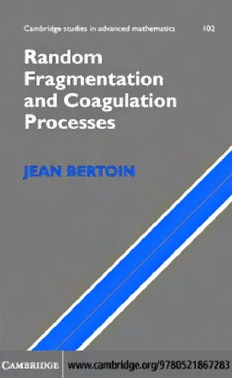
Random fragmentation and coagulation processes PDF
Preview Random fragmentation and coagulation processes
This page intentionally left blank CAMBRIDGE STUDIES IN ADVANCED MATHEMATICS 102 RANDOM FRAGMENTATION AND COAGULATION PROCESSES Fragmentationandcoagulationaretwonaturalphenomenathatcanbeobserved inmanysciencesandatagreatvarietyofscales.Thisbookisthefirstcompre- hensivetheoreticalaccountofmathematicalmodelsforsituationswhereeither phenomenon occurs randomly and repeatedly as time passes. Thefragmentationandcoalescentprocessesconsideredinthistextdescribe the evolution of particle systems, where particles are characterized by their sizes.Inafragmentationprocess,eachparticlesplitsataratewhichdepends on its size, and independently of the other particles. In a coalescent process, coagulations occur at rates which depend only on the particles involved in the merging, and not on the other particles in the system. The book starts by developing the theory of fragmentation chains, that is processes in which each fragment remains stable for some random time and then splits; it then turnstothegeneralsituationwhereeachfragmentmaysplitinstantaneously, using Kingman’s theory of exchangeable random partitions. Then, two quite differenttypesofcoagulationprocessareconsidered:“exchangeable”coales- cents, where rates of coagulation do not depend on the masses in the system and coagulations may occur simultaneously and involve an arbitrary number ofcomponents,and“stochastic”coalescents,whereonlybinarycoagulations are permitted and the rate of such coagulation may depend on the two frag- ments involved. This self-contained treatment develops the models in a way that makes recentdevelopmentsinthefieldaccessibletoreaderswithasolidbackground inprobability.Eachchapterendswithacommentssectioninwhichimportant aspectsnotdiscussedinthemainpartofthetext(oftenbecausethediscussion would have been too technical and/or lengthy) are addressed and precise references are given. Cambridge Studies in Advanced Mathematics Editorial Board: B.Bollobas,W.Fulton,A.Katok,F.Kirwan,P.Sarnak,B.Simon,B.Totaro All the titles listed below can be obtained from good booksellers or from CambridgeUniversityPress.Foracompleteserieslistingvisit: http://www.cambridge.org/mathematics Alreadypublished 68 K.SatoLévyprocessesandinfinitelydivisibledistributions 69 H.HidaModularformsandGaloiscohomology 70 R.Iorio&V.IorioFourieranalysisandpartialdifferentialequations 71 R.BleiAnalysisinintegerandfractionaldimensions 72 F.Borceaux&G.JanelidzeGaloistheories 73 B.BollobásRandomgraphs 74 R.M.DudleyRealanalysisandprobability 75 T.Sheil-SmallComplexpolynomials 76 C.VoisinHodgetheoryandcomplexalgebraicgeometry,I 77 C.VoisinHodgetheoryandcomplexalgebraicgeometry,II 78 V.PaulsenCompletelyboundedmapsandoperatoralgebras 79 F. Gesztesy & H. Holden Soliton Equations and Their Algebro-Geometric Solutions,I 81 S.MukaiAnIntroductiontoInvariantsandModuli 82 G.TourlakisLecturesinLogicandSetTheory,I 83 G.TourlakisLecturesinLogicandSetTheory,II 84 R.A.BaileyAssociationSchemes 85 J.Carlson,S.Müller-Stach&C.PetersPeriodMappingsandPeriodDomains 86 J.J.Duistermaat&J.A.C.KolkMultidimensionalRealAnalysisI 87 J.J.Duistermaat&J.A.C.KolkMultidimensionalRealAnalysisII 89 M.Golumbic&A.TrenkToleranceGraphs 90 L.HarperGlobalMethodsforCombinatorialIsoperimetricProblems 91 I.Moerdijk&J.MrcunIntroductiontoFoliationsandLieGroupoids 92 J.Kollar,K.E.Smith&A.CortiRationalandNearlyRationalVarieties 93 D.ApplebaumLévyProcessesandStochasticCalculus 94 B.ConradModularFormsandtheRamanujanConjecture 95 M.SchechterAnIntroductiontoNonlinearAnalysis 96 R.CarterLieAlgebrasofFiniteandAffineType 97 H.L. Montgomery, R.C. Vaughan & M. Schechter Multiplicative Number TheoryI 98 I.ChavelRiemannianGeometry 99 D.GoldfeldAutomorphicFormsandL-FunctionsfortheGroupGL(n,R) 100 M.B. Marcus & J. Rosen Markov Processes, Gaussian Processes, and Local Times 101 P.Gille&T.SzamuelyCentralSimpleAlgebrasandGaloisCohomology RANDOM FRAGMENTATION AND COAGULATION PROCESSES JEAN BERTOIN Laboratoire de Probabilités et Modèles Aléatoires Université Pierre et Marie Curie cambridge university press Cambridge, New York, Melbourne, Madrid, Cape Town, Singapore, São Paulo Cambridge University Press TheEdinburghBuilding,Cambridgecb22ru,UK Published in the United States of America by Cambridge University Press, New York www.cambridge.org Information on this title: www.cambridg e.org /9780521867283 ©J.Bertoin2006 Thispublicationisincopyright.Subjecttostatutoryexceptionandtotheprovisionof relevantcollectivelicensingagreements,noreproductionofanypartmaytakeplace withoutthewrittenpermissionofCambridgeUniversityPress. Firstpublishedinprintformat 2006 isbn-13 978-0-511-24577-0eBook(EBL) isbn-10 0-511-24577-7 eBook(EBL) isbn-13 978-0-521-86728-3hardback isbn-10 0-521-86728-2 hardback CambridgeUniversityPresshasnoresponsibilityforthepersistenceoraccuracyofurls forexternalorthird-partyinternetwebsitesreferredtointhispublication,anddoesnot guaranteethatanycontentonsuchwebsitesis,orwillremain,accurateorappropriate. Contents Introduction page 1 1 Self-similar fragmentation chains 6 1.1 Construction of fragmentation chains 6 1.1.1 Preliminaries on Markov chains 7 1.1.2 Branching Markov chains 11 1.1.3 Fragmentation chains 16 1.2 Genealogical structure 23 1.2.1 The tree of generations 24 1.2.2 Malthusian hypotheses and the intrinsic martingale 26 1.2.3 A randomly tagged branch 31 1.3 Extinction and formation of dust for (cid:2)<037 1.3.1 Extinction 38 1.3.2 Formation of dust 40 1.4 Some strong laws for (cid:2)≥043 1.4.1 A variation of the law of large numbers 44 1.4.2 The homogeneous case ((cid:2)=0) 46 1.4.3 The case (cid:2)>049 1.4.4 Another strong law via renewal theory 53 1.5 Additive martingales (homogeneous case (cid:2)=0) 55 1.5.1 Convergence of additive martingales 56 1.5.2 Some applications 58 1.6 Comments 62 2 Random partitions 66 2.1 Mass-partitions 66 2.1.1 Partitions of a unit mass 66 2.1.2 Interval-partitions 68 2.1.3 Size-biased sampling and reordering 71 v vi Contents 2.2 Random mass-partitions and Poisson measures 74 2.2.1 Multidimensional Dirichlet distributions 75 2.2.2 Some preliminaries on Poisson random measures 78 2.2.3 Mass-partitions induced by Poisson measures 81 2.2.4 Gamma subordinators and Dirichlet processes 87 2.2.5 Stable subordinators and Poisson-Dirichlet partitions 90 2.3 Exchangeable random partitions 94 2.3.1 Some definition 95 2.3.2 Kingman’s theory 97 2.3.3 Exchangeable partition probability functions 105 2.4 Comments 110 3 Exchangeable fragmentations 112 3.1 Homogeneous fragmentation processes 112 3.1.1 Fragmentation of partitions 114 3.1.2 Homogeneous fragmentation as Markov processes 119 3.1.3 Poissonian structure 124 3.2 Asymptotic frequencies 125 3.2.1 Erosion and dislocation 126 3.2.2 Subordinator representation of the tagged fragment 132 3.2.3 Lévy-Itô decomposition of the tagged fragment 140 3.3 Self-similar fragmentations 144 3.3.1 Definition and first properties 145 3.3.2 Changing the index of self-similarity 149 3.3.3 Mass-fragmentations 152 3.4 Comments 160 4 Exchangeable coalescents 163 4.1 Kingman’s coalescent 163 4.1.1 Genealogy of populations in the Wright-Fisher model 163 4.1.2 Construction of Kingman’s coalescent 165 4.1.3 Interval representation of Kingman’s coalescent 171 4.2 Simultaneous and multiple coagulations 173 4.2.1 Coagulation of partitions 174 4.2.2 Exchangeable coalescents and coagulation rates 177 4.2.3 Poissonian construction 179 4.2.4 Characterization of coagulation rates 181 4.3 Exchangeable mass-coalescents 185 4.3.1 Markov property 185 4.3.2 Dust in exchangeable mass-coalescents 187 Contents vii 4.4 Simple coalescents and flows of bridges 189 4.4.1 Compositions of simple bridges 190 4.4.2 Flows of bridges and coagulation 196 4.4.3 The dual flow and a population model 200 4.4.4 The Bolthausen-Sznitman coalescent 205 4.5 Comments 211 5 Asymptotic regimes in stochastic coalescence 214 5.1 Stochastic coalescence 214 5.1.1 Coalescent chains 215 5.1.2 Extension to infinite systems 218 5.2 Hydrodynamic behavior and Smoluchowski’s equations 226 5.2.1 The multiplicative kernel 227 5.2.2 Sub-multiplicative kernels 235 5.3 The additive coalescence 244 5.3.1 Some basic properties 244 5.3.2 Coagulation of trees in a random forest 247 5.3.3 The standard additive coalescent 254 5.3.4 A dual fragmentation process 258 5.4 Comments 261 References 264 List of symbols 276 Index 279
